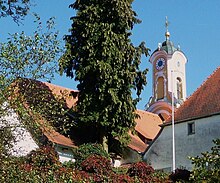Neufraunhofen Castle

Castle Neufraunhofen is in Neufraunhofen in Lower Bavaria located castle with attached church. It is privately owned.
history
According to a chronicle written by Georg Graf von Soden-Fraunhofen, the place where the village of Neufraunhofen extends today was originally a noble seat called Öd, which was first mentioned in 1180. That is the year in which Otto von Wittelsbach was appointed Duke of Bavaria after Heinrich the Lion was deposed by Emperor Barbarossa. The lords of Öd exercised the gift office at the Wittelsbach court, which gave their ancestral seat Öd, which means something like father's estate, an ancestral farm located in the desert, the name "Schenkenöd".
Around 1390 Wilhelm von Fraunhofen took over the seat, rebuilt the castle and had it renamed New Fraunhofen, while his cousin stayed in Fraunhofen, which was now called Old Fraunhofen. Alt- and Neufraunhofen were imperial fiefs that were only subordinate to the emperor. The castle buildings with church in Neufraunhofen were given their present appearance between 1709 and 1720 through partial renovations and extensions. Through the Reichsdeputationshauptschluss 1803, the direct imperial rule of the imperial barons of Fraunhofen was mediated and at the end of 1805 the two localities were incorporated into the Bavarian Rhine Federation Act.
The line ended with Carl August Freiherr von Fraunhofen in 1865. The royal chamberlain and hereditary imperial councilor of the Bavarian crown appointed his nephew Maximilian Freiherrn von Soden (* 1844 in Ludwigsburg) as heir, who was now called Maximilian von Soden-Fraunhofen . He was appointed Minister of State in 1916 by King Ludwig III. Elevated to the hereditary count and died in 1922. The castle belongs to his family to this day.
Building description
The irregular three-wing complex includes the manor house, which is followed by the church, the former Capuchin hospice, farm buildings, a tavern (around 1646) and a former court house. The castle is surrounded by a park from the 19th century. The castle church of St. John the Baptist was built from 1709 to 1714 on the Gothic foundation walls from 1409 and provided with a rococo facade in 1753 . In the 1830s the church was extended to the north by a side aisle. The interior is from the years 1715 to 1750. In the church of today's Kuratie Neufraunhofen there are several tombs of the Lords of Fraunhofen from the 15th to 19th centuries.
literature
- Marianne Mehling (Ed.): Knaur's cultural guide in color. Lower Bavaria and Upper Palatinate. Droemer Knaur, Munich 1995, ISBN 3-426-26647-4 .
- Georg Graf von Soden-Fraunhofen: Alt- and Neufraunhofen: A contribution to the local and building history. Self-published, Neufraunhofen 1966.
Web links
Coordinates: 48 ° 25 ′ 45.1 ″ N , 12 ° 18 ′ 33.3 ″ E


